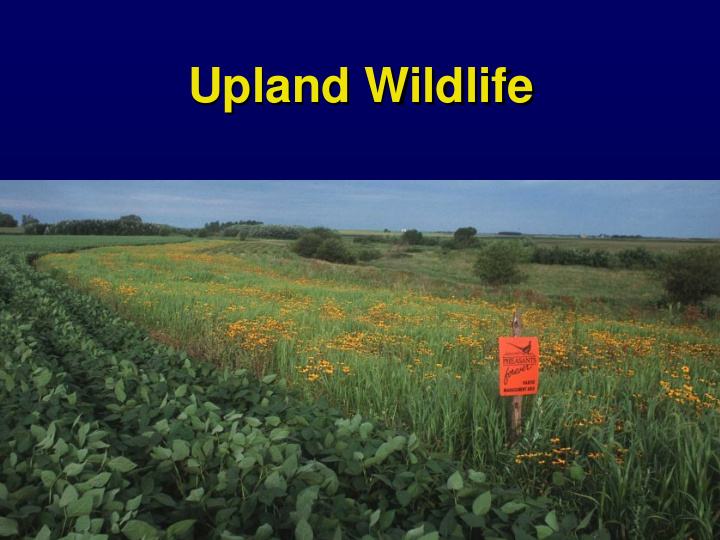



Upland Wildlife
The majority of upland wildlife habitat in the lower 48 is on private lands, much of it in agricultural use
Essential Partners! Land use decisions made by farmers and ranchers have great influence on upland wildlife
Agricultural production practices changed throughout the 20th Century From low-input, simple systems to high-input, intensively managed operations
Many natural ecosystem processes have been disrupted, resulting in declines in many upland wildlife populations.
Upland wildlife challenges Habitat degradation Habitat fragmentation Exotic and invasive species
Upland wildlife challenges Predation and nest parasitism Environmental contaminants Urbanization Modification of disturbance regimes
Traditional NRCS wildlife technical assistance focused on farm game species • Driven by landowner objectives • Typically seen as secondary land use • Farm game is still a major focus
Assistance is moving toward the Landscape Focus • Rare and declining habitats (e.g., tall-grass prairie, riparian habitats, early successional) • Regionally important wildlife species (e.g., northern bobwhite, sage grouse) • Requires integrating landscape level planning with individual landowner objectives and targeted species’ habitat requirements
Planning must reach from the field and farm scale to the watershed and beyond
Upland Wildlife Habitat Principles Develop reliable food sources • Maximize variety of foods available • Buds and seeds • Fleshy fruits & berries • Substrate for invertebrates • Focus on native plant species
Upland Habitat Principles Optimize vegetation diversity Consider year-round food and cover needs Use native plant materials where possible
Upland Habitat Principles Type and structure of vegetation Wildlife value Monoculture No. of plant species Many Simple Vegetation structure Diverse
Species-specific Response Bobolink Dickcissel All grass Grass-forb mix
Species-specific Response Non-native Native Vegetation
Upland Habitat Principles Management and maintenance Timing is essential! Ground-nesting birds that attempt to nest in hayfields often re-nest in strip habitats Mowing buffers should be delayed to allow second nesting attempts to succeed Avoid night mowing of hay fields and buffers to minimize adult mortality
Upland Wildlife Habitat Management Tools Burning Grazing Disking IPM Residue Mgmt. Herbicides
Prescribed Burning Timing is critical (late fall - early spring) • Rotate burn areas • Patches and mosaics desirable
Prescribed Grazing • Close control of timing and intensity • Useful in controlling exotics • Excellent management tool when used properly • Use in lieu of herbicides • Restrict access to wetlands and riparian areas during nesting season • Manage access to sensitive riparian areas to protect aquatic habitat.
Herbicide Application • Timing is critical • Excellent management tool when used properly • Use only when necessary • Use “weed sweep” and other methods that limit amount of herbicide used
Light Disking • Excellent management tool for releasing seed- producing annuals and breaking up dense sod
Conservation Tillage Nesting substrate Fall and winter cover Waste grain & invertebrate foods
Conventional Field Operations Corn: Plant Hoe Cult . Soybeans: Plant Hoe Cult. Till Cult. May June July Aug Vesper sparrow nesting season : # Nests May June July Aug
Integrated Pest Management Emphasize IPM and biological agents to encourage diversity Beneficial insects Raptor perches and boxes Bat boxes Minimize drift to adjacent habitats
Conservation planners: - Uniquely positioned to help landowners maintain and establish upland wildlife habitat on agricultural landscapes! Along with traditional farm game, incorporate other upland wildlife to the extent possible, such as….
Migratory Pollinators Declines due to: 1. Exposure to pesticides & herbicides 2. Reduced availability of nectar 3. Competition from exotic plants 4. Destruction of roosting habitat
Migratory Pollinators Nectar Corridor “The sequence of flowering plants that provides migrants with sugars and amino acids to fuel their long distance flights. By doing so, they incidentally transfer pollen from one plant to another thus increasing the probability of genetic mixing, seed set, and reproduction for their floral hosts.”
Bats Number of bat species 45 U.S species
BATS • 920 species Worldwide - 1/4 of all mammals • Important for pollination and insect control • 40% of North American bats are in decline or listed as T or E • Decline has negative economic impact on agriculture Bat Conservation International
Reptiles & Amphibians (Herps) • Healthy populations of Herps can benefit Farm Operations: They prey on insects, rodents, and other pests. • Most Herps are in decline because of loss and degradation of their habitats. • The fate of Herps is in the hands of Private Landowners east of the 100 th Meridian of the U.S. • Conservation Buffers can develop and connect corridors used to move to various habitats used during life history. • Herps do not fly; they generally move slowly!
Grassland Birds • Grassland-nesting birds are in decline due to habitat loss and fragmentation • Conservation buffers and other strip habitats are important habitats in agricultural landscapes
Grassland Birds
Upland wildlife opportunities in USDA Conservation Programs Wildlife Habitat Incentives Program Provides funding for wildlife habitat work under cost-share agreements
Upland wildlife opportunities in USDA Conservation Programs Conservation Reserve Program Provides rental payments and cost-share for cover management under 10 to 15-year contracts.
Upland wildlife opportunities in USDA Conservation Programs Environmental Quality Incentives Program Provides cost-share for conservation practices addressing soil, water and wildlife concerns.
Upland wildlife opportunities in USDA Conservation Programs Conservation Security Program Provides payments for conservation stewardship.
Everything we do on the land affects Fish and Wildlife!
Recommend
More recommend